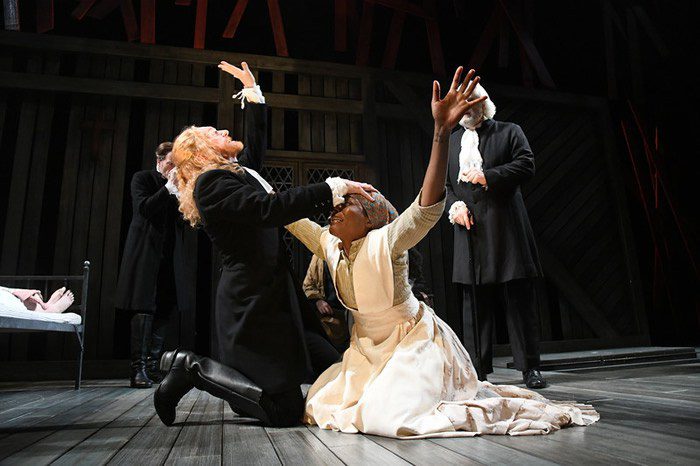A ‘Crucible’ Raw to the Ear, Eye and Heart
By • April 23, 2018 0 947

In any production of “The Crucible,” Arthur Miller’s 1953 play about the Salem witchcraft trials, context often and perhaps inevitably plays an important part.
Miller himself indicated that he meant to draw comparison to the House Un-American Activities Committee hearings of the period, as well as to the hearings headed by demagogic Wisconsin Sen. Joseph McCarthy. It was a time when people in the State Department, the armed services and Hollywood were arrested, subpoenaed and pressured to give names of friends, neighbors and so-called fellow travelers suspected of being Communists.
The inferences were pretty clear and remain so. In the Puritan town of Salem, Massachusetts, in the 1600s, people both good and venal, religious and skeptical, powerful and not fell under suspicion, the victims of accusations by a group of young girls apparently in the grip of witchcraft. The result: as the accusations mounted, judges pushed the accused not towards truth but confessions. Twenty people were hanged, most of them women. The episode, often seen as an illustration of mass hysteria, has become widely known, making Salem a popular tourism destination.
It is all too easy to think of our present situation, in which accusations of “witchhunt” are bandied about almost casually at the highest level and extreme elements on the left and right level vicious accusations online and off.
The connections to our present political battles are not so obvious in “The Crucible.” The play, and especially the new production at Olney Theatre Center, running through May 20, remain resolutely in their time, emitting not so much a need for comparison as a gut-punch echo of our own frailties and easy cynicism.
We live in noisy times and that’s one comparison that holds true. This production, directed with great energy by Eleanor Holdridge, is full of noise, emotional noise especially, raw to the ear, eye and heart, as the characters, many of them real historical figures, struggle with their desires, morals and allegiances to God, community and family.
That struggle almost becomes an act of witness, makes you feel like a survivor of a time when self-interest, faith, love, the charitable impulse, truth and justice were engaged in mortal combat, which almost destroyed Salem, instead making it both famous and infamous.
When a group of young girls dancing in the woods (one of them apparently naked) are spied by the local minister, the self-righteous Reverend Parris, all hell is suspected to be breaking loose. Under the spell and leadership of the manipulative and sensual Abigail, the girls produce fainting spells at will, and accuse all who accuse them. Soon, a tolerant Reverend Hale arrives, followed by a stern, literal-minded and merciless Judge Danforth, like a a searing blast of unjust winter.
No one is above suspicion, not bellowing and fearless landowner Giles Corey (played with full-bodied gusto by Craig MacDonald), not a kindly nurse accused of killing children and especially not John and Elizabeth Proctor — she a quiet, subdued housewife, he a shining pillar of the community. Unfortunately, John had a brief sexual encounter with Abigail, which haunts him still and which is the driving force behind Abigail’s animus toward both.
What ensues is remarkable for its raw power. Kudos goes to a stellar cast of 19, headed by Chris Genebach as John and Rachel Zampelli as Elizabeth. Genebach is a frustrated tower of fury and self-guilt as he attempts to save his wife, whom he loves deeply. He’s a bellow of emotion and suffering, all the more because he exudes strength and goodness in spite of his self-evident (not to him) goodness.
Zampelli is the exact opposite. Quiet and low-key, her fires subtly banked, she nevertheless manages to show us all her hidden virtues. Together, their plight, which is a true tragedy, turns into an uncomfortable triumph.
Scott Parkinson is a revelation as the Reverend Hale, turning from confident seeker of truth to battered disbeliever, and Paul Morella as Danforth is a human being as a stone, impenetrable in his relentless quest to mete out rough justice.
They’ve created a world here at Olney: an abstract set made dense and detailed with the props and details of daily life — dinner table, tablecloth, costumes, dishes, the glasses full of preserves — that seem indestructible, but falter when their owners fall.
The production isn’t by any means perfect. Miller’s stately, poetic language sometimes gets modern nicks by some cast members; the pain sometimes gets to be a little much. But the truth is, whether or not witches can really fly, this production does.

